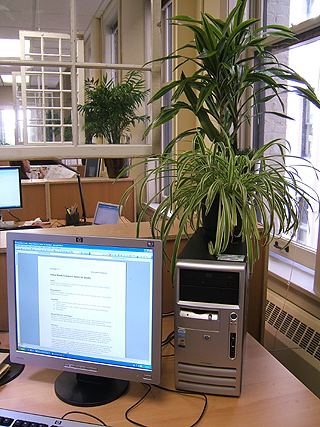
DJC.COM
February 19, 2009
Small measures can save big bucks during downturn
O’Brien & Co.

O'Brien
|
Here in Washington, where people have been green longer than it’s been in style, the green building industry has been thriving for more than a decade.
Our state was the first in the nation to require publicly funded buildings be built to green standards. Several cities, towns and counties in the state have incorporated green building guidelines and incentives as well.
By 2008, Washington had more than 500 certified or registered LEED buildings, more than 20,000 Built Green homes and hundreds in queue for LEED for Homes certification.
Despite the continuing growth of green building, there has been bad news in the industry as the economic crisis continues to unfold. New construction projects are being put on hold. Firms large and small are laying off staff. Even those who haven’t experienced a personal hit seem to be hunkering down for 2009.

Photo courtesy of O’Brien & Co. A horticulturist at O’Brien & Co. installed office plants to remove toxins from the air, earning the firm a LEED innovation credit. Steps to remove indoor irritants can improve worker productivity and save labor costs. |
The good news is that green building presents a solution in the downturn, and will actually help those who own, rent and/or operate existing buildings to beat the 2009 economic blues.
Squeezing out savings
Companies are searching for even more ways to squeeze the most out of their assets.
According to the California Energy Commission, about half of the current stock of commercial building space was built before 1978. That’s billions of square feet of existing buildings that could benefit from energy upgrades.
Even fairly minor changes can save as much as 10 percent of the energy now used to operate them. With a little more thought, 20 percent is quite achievable.
Energy efficiency isn’t the only place to find savings. For tenants, increased productivity can be a major boon, especially as staff numbers go lean and mean. O’Brien & Co.’s LEED gold office in Seattle’s historic Colman building offers its 20-plus staff members great daylighting, natural ventilation, easy transit access to and from the office, and a good mix of open and private spaces to help us get our work done.
Boosting performance
What’s the best way to mine this green gold?
For building owners and facility managers, energy efficiency is a no-brainer: it provides some insurance against rising energy costs and reduces global warming. Energy-related upgrades can even pay for themselves if done right.
While this year might not be the time to do a major remodel, there are simple things facility managers can do to boost their buildings’ performance:
• Commissioning. The U.S. Department of Energy reports that, on average, office buildings use $1.34 of electricity per square foot, whereas the national average for commercial buildings is only $0.99 per square foot.
They also have found that most energy audits can identify 5 percent to 10 percent savings by making a few low- or no-cost changes, as simple as correcting system overrides that may have been left on.
Additionally, the proper staging and sequencing of boilers, chillers and air-conditioning units can prevent simultaneous heating and cooling.
• Training. If you want your building to run like a well-oiled machine, you’ll need a team of well-trained facilities staff. The International Facilities Management Association offers many courses that cover topics such as operations and maintenance competency and sustainable facilities management.
Worker productivity
For tenants, labor costs are the highest costs. Strategies that improve the indoor environmental quality of their space will pay back in worker health and productivity:
• Purchasing refurbished furniture. The quality of indoor air can have a dramatic impact on productivity. Just ask an allergy sufferer who can’t see her screen through weepy eyes.
Purchasing refurbished furniture is not only cheaper and more environmentally friendly, it’s less likely to emit chemicals that can irritate workers’ respiratory systems.
• Indoor plants. Certain species of indoor plants can remove toxins from the air.
O’Brien & Co.’s in-house horticulturist, Sue Nicol, researched the options and created a plan for our new office to install just the right number of plants per person to keep our air free from harmful toxins. This effort earned us an innovation credit in our LEED for Commercial Interiors certification and makes the workplace a healthier and more inviting place to be.
A joint effort
Depending on the lease, some sustainable actions do not provide direct financial benefit.
When building managers improve the air quality of their buildings, their tenants are the ones to see a savings in the form of increased productivity. If a tenant aggressively recycles, the building management saves in the reduced cost of solid waste hauling.
“Doing the right thing” is nice, but with the economy the way it is, companies will be looking hard at how every penny spent brings in at least an equal reward (or lots more). Here are some ways to cross the leasing divide to make the building better for everyone.
Owners and facility managers:
• Include an indoor environmental quality assessment as part of your energy efficiency efforts. Conduct an occupant satisfaction survey on thermal comfort and air quality.
• Create a green housekeeping contract and make sure all your cleaning is done with chemicals that won’t pollute your indoor air.
Tenants:
• Reduce waste. Most people in Seattle are pretty good at recycling, but most offices could do a better job of reducing waste at the source. That could mean buying regular office supplies in less packaging, buying more reusable products instead of disposable, and using less paper by setting up a system to easily use the blank sides of paper. Source reduction offers a clear win-win, as it means less cost for waste hauling for the property manager and savings for the purchaser, too.
• Turn off unnecessary lights and equipment. Although it may occasionally be necessary for backups or other IT needs, it’s never an energy saver to leave a computer on all night. Create a clear checklist of office closing procedures and make sure they’re followed. We’ve found that occasional audits with a latte reward are a good incentive.
Benefits of LEED-EB
For highly motivated property managers and tenants, the LEED for Existing Buildings: Operations & Maintenance (LEED-EB) rating system can provide a guideline for your combined efforts as well as a marketing angle that, with third-party verification, can set a building apart from the crowd of greenwashers.
Several credits in LEED-EB require building managers and tenants to work together.
For example, buildings receive credit if a minimum of 50 percent of their total purchases — including purchases made by their tenants — meet specific environmentally preferred criteria. LEED-EB also requires documentation that 50 percent to 70 percent of a building’s waste is reused or recycled rather than sent to a landfill or incinerator.
Management’s role in this case is to support tenants’ recycling efforts, for example, by installing convenient recycling receptacles. Other credits, like points for reductions in single-car commute trips, don’t technically require cooperation, but can hardly succeed without the support of management and participation by tenants.
It’s easy with the newspapers and blogs screaming panic in their headlines to lose sight of the tremendous opportunity that green building offers — especially with existing buildings. It’s fortuitous that LEED-EB provides a framework for taking advantage of this opportunity and meeting the 2009 challenge.
Kathleen O’Brien is the founding president of O’Brien & Co., a green building and sustainability consulting firm that offers training, green building consulting, and policy and program development services.
Other Stories:
- Tenants can go green even if the landlord isn't
- LEED residential program encourages healthy homes
- Time to get serious about conserving energy
- How parking rules make cities less walkable
- Bog won’t sink this eco-friendly project
- Bank bailout has incentives for green building
- How Seattle can help green roofs to really grow
- Green school offers lessons on sustainability
- What owners need to know about LEED
- Want LEED credits for your lights? Plan early
Copyright ©2009 Seattle Daily Journal and DJC.COM.
Comments? Questions? Contact us.